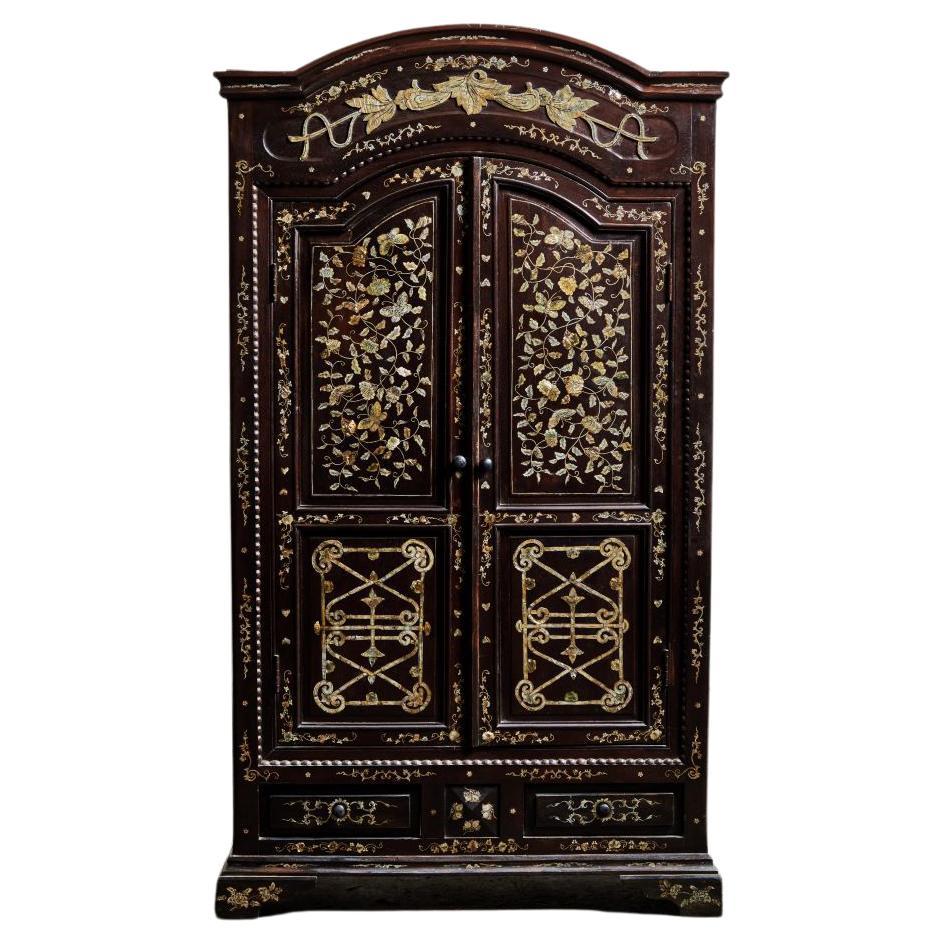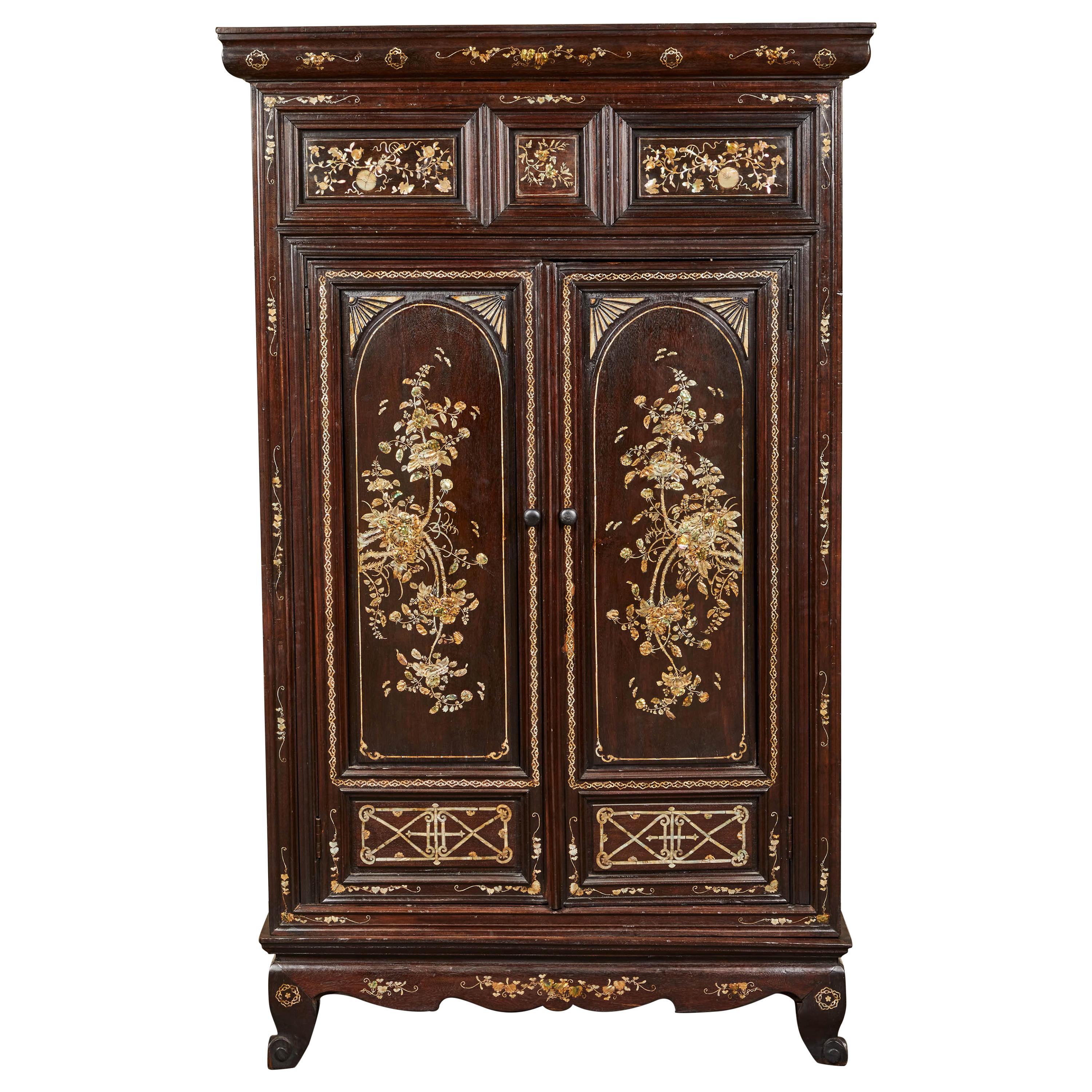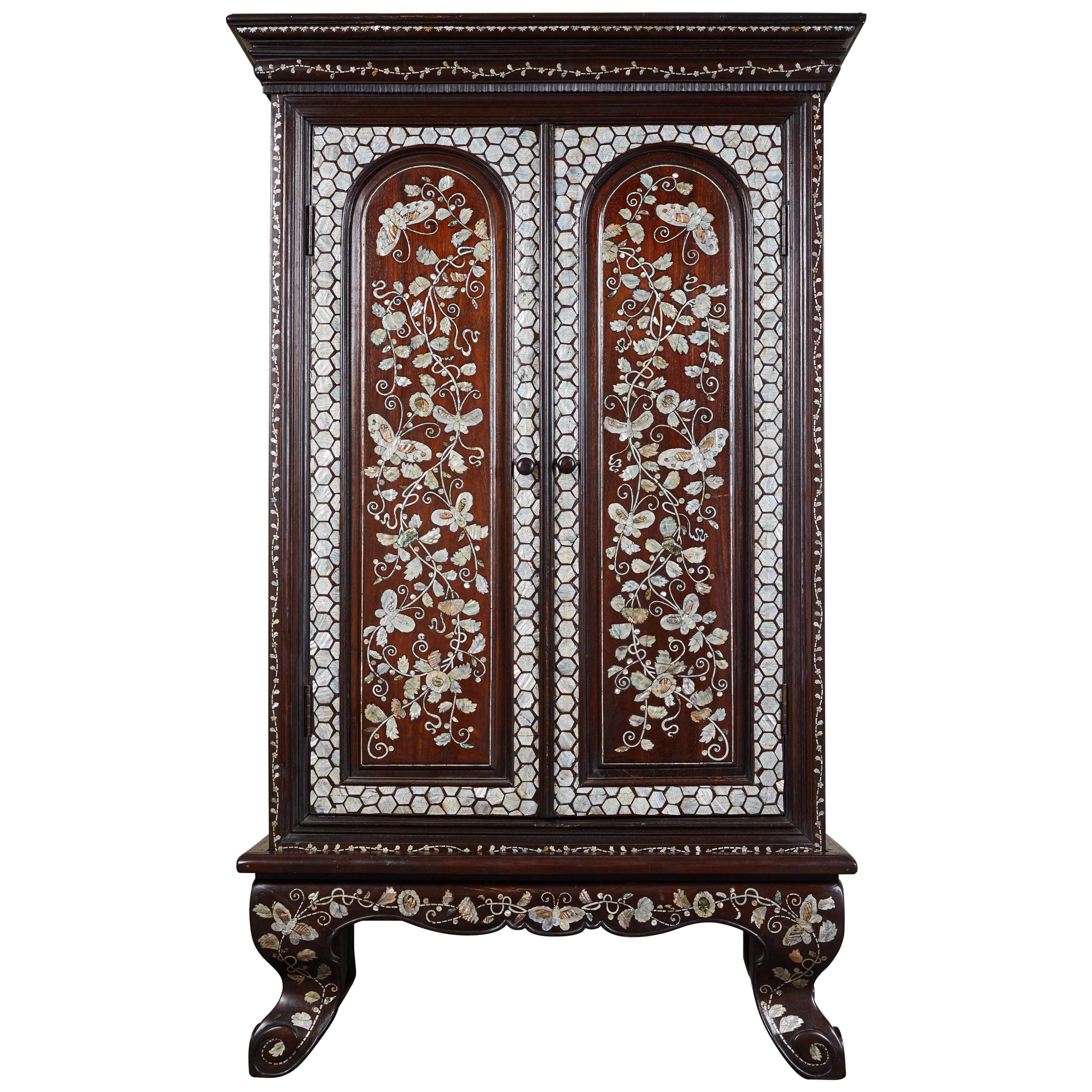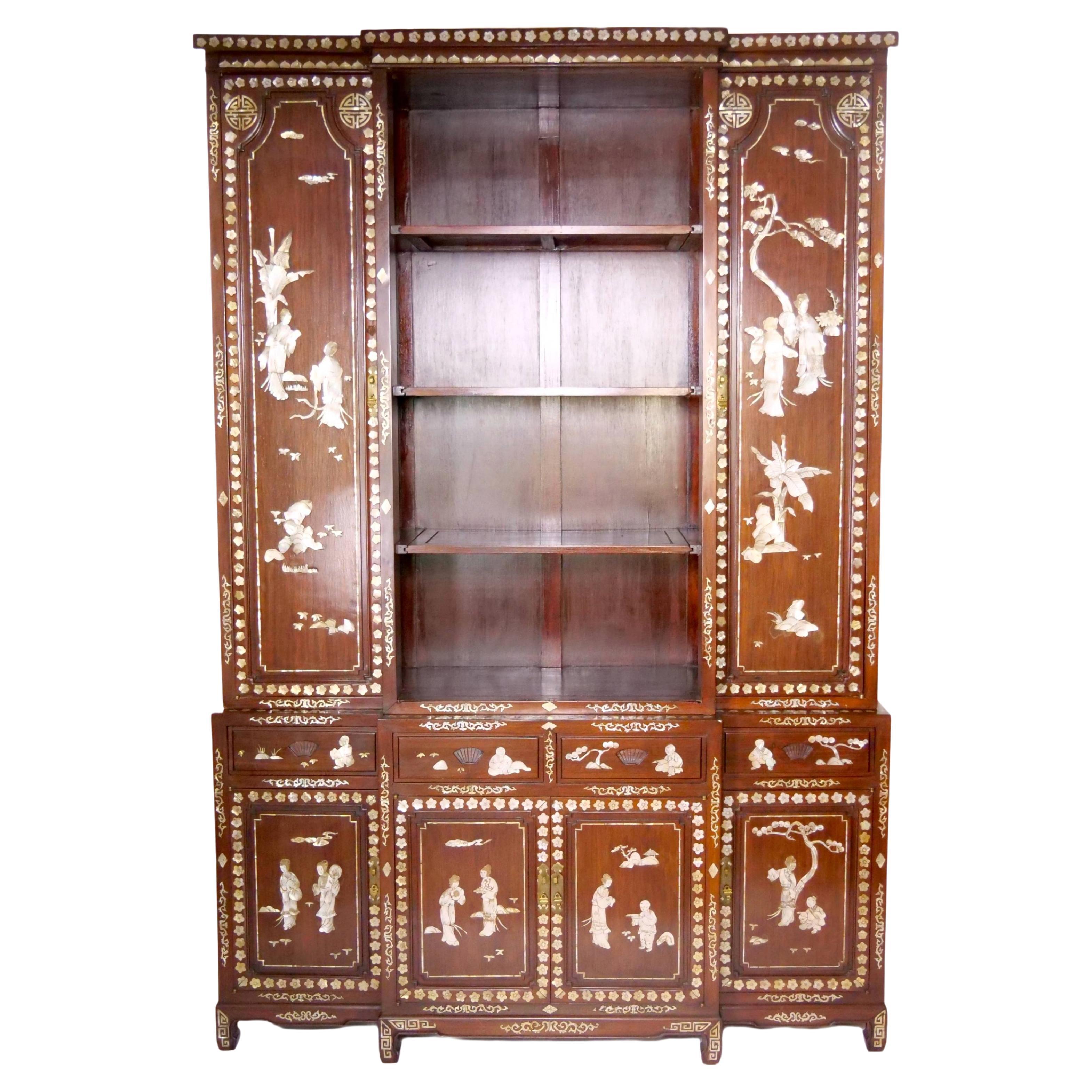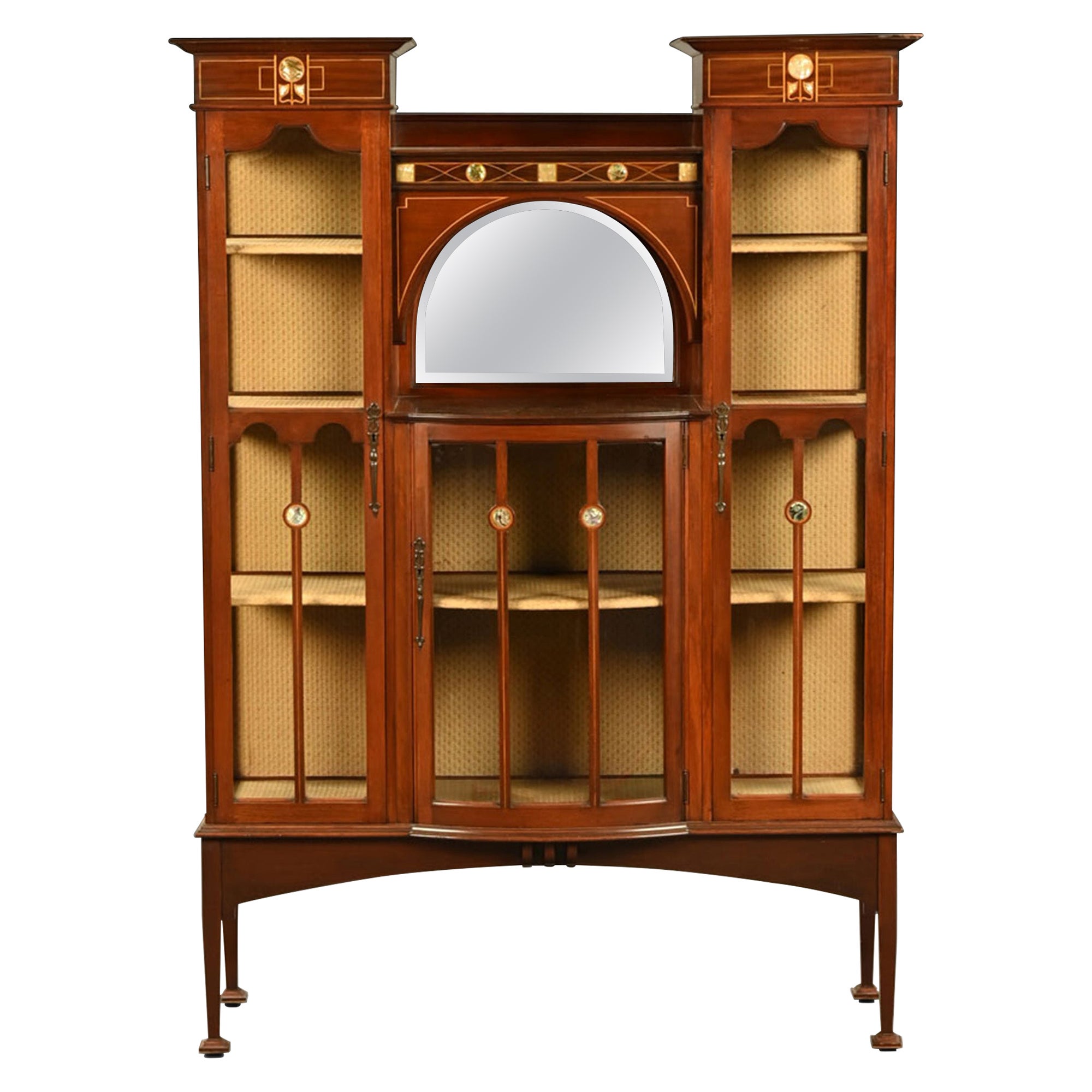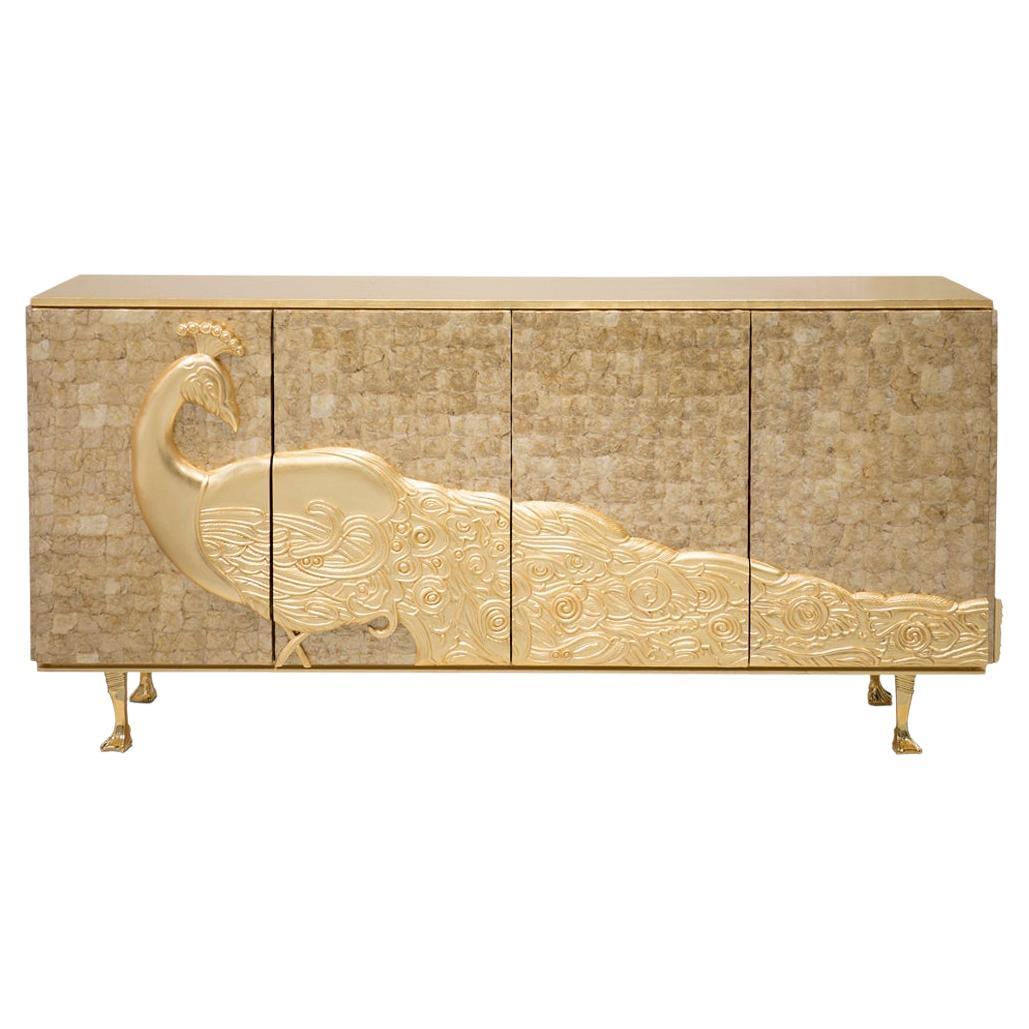Items Similar to A pair of Spanish-colonial Viceregal mother-of-pearl inlaid bureau-cabinets
Want more images or videos?
Request additional images or videos from the seller
1 of 11
A pair of Spanish-colonial Viceregal mother-of-pearl inlaid bureau-cabinets
About the Item
Viceroyalty of Peru, Lima, 18th century, circa 1720-1760
Each with a moulded giltwood cornice and on a foliate carved giltwood base, possibly later and English. The cabinets, with silver mounts, are made of cedar, overall inlaid with mother-of-pearl. The interior is veneered with teak, American crabwood, Gele kabbes, and boxwood.
H. 213 x W. 115 x D. 52.5 cm (each)
Provenance:
Noble collection, United Kingdom; thence by descent
These spectacular bureau-cabinets are part of a fascinating production of decorative art and furniture from Lima, the affluent capital of the Spanish Vice-Royalty of Peru. Included are mother-of-pearl covered altarpieces, lecterns, caskets, boxes, tables, coffers, cabinets, and presumably the rarest: impressive bureaux such as the present pair. They are exquisite material examples of cultural cross-pollination in South and Central America, bridging multiple influences from Asia and Europe in a result that is both visually and historically impactful.
Indian, Korean, Chinese, Japanese and Arabian influence
This pair of cabinets is especially appealing for its shimmering surface of mother-of-pearl veneer, which was described as enconchado in inventories. It has as precursors the ‘Indo-Portuguese’ caskets, jugs and bowls, often silver mounted, produced in the Indian region of Gujarat in the 16th and early 17th centuries. These were shipped from Goa, the Portuguese colonial trade post on the west coast of India, to Portugal intended for the greatest monasteries, cathedrals and palaces of the country. Already in 16th century these lustrous Gujarati caskets, with nacre veneer fastened with silver nails in a fish-scale pattern were considered so precious in Europe that they were classified as jewellery in the inventories of royal collections and even nowadays they still are regarded as the most sought after works of art.
The Portuguese used the shimmering treasures from Gujarat as diplomatic gifts, which is how they ended up in the famous Habsburger kunstkammers of Vienna and Dresden. More important in this case are the reliquary caskets and other religious wares that ended up in collections of several Spanish monasteries and churches, as well as the games- boards and table-tops that were centrepieces in the homes of the most notable Spaniards.
With the establishment of more Portuguese trade routes within Asia, the Indian mother-of-pearl objects influenced the Japanese lacquer production. In large numbers the Portuguese ordered lacquerware for the purpose of being exported to Europe or big colonial cities like Spanish Manilla. The Spanish Manilla Galleon trade brought these objects to South America and, thus, to the Viceroyalty of Peru. It didn’t take long before there was a true rage for furniture decorated with nacre. However, the Portuguese controlled the market as they had monopolized access to the ports where the pieces could be ordered, such as Gujarat and Japan. Paying high prices, the Spaniards exported the goods to the Viceroyalties, where they enjoyed enormous popularity amongst the affluent class, particularly in Mexico and Peru. It wouldn’t be long before the Spanish brought Asian craftsmen to South America to produce these iridescent works of art themselves.
By the 18th century, the regular flow of the Manilla galleons from Manilla to Acapulco introduced an enormous quantity of Asian luxury items in both the Vice-Royalties of New Spain and Peru, with immediate and apparent influences on the local craftsmen and taste of the elites. The Asian influences in technique and motifs arrived from goods and through Asian craftsmen. Japanese and Chinese workers brought the techniques of inlaying materials (lacquer, a sort of gum or tree sap called mastic, wood, tortoiseshell, and much more) with mother-of-pearl. Arabs, who had to ‘convert’ to Christianism before they were allowed to immigrate, brought in Múdejar skills and their distinctive abstract approach to ornament without the imagery of animals or humans, as stated in the Quran. These cabinetmakers with all sorts of backgrounds in Mexico and Peru started to produce the finest inlaid and or veneered furniture and objects in the 17th and 18th centuries in their own style – each influenced by various available techniques and motifs. The most popular among the buyers would eventually become dominant.
Reflecting the syncretic nature of the present bureau- cabinets, the floral design of the mother-of-pearl veneers appears to have been inspired by ancient Korean designs from the Joseon or Chosõn Dynasty, seen in porcelain and objects with mother-of-pearl inlays on wood grounds. These designs are also seen in another Peruvian technique, which uses mother-of-pearl inlays on a tortoiseshell ground. However, most Far Eastern mother-of-pearl techniques find their origins in Korea.
- Dimensions:Height: 83.86 in (213 cm)Width: 45.28 in (115 cm)Depth: 83.86 in (213 cm)
- Style:Spanish Colonial (Of the Period)
- Materials and Techniques:
- Place of Origin:
- Period:
- Date of Manufacture:1720-1760
- Condition:Wear consistent with age and use.
- Seller Location:Amsterdam, NL
- Reference Number:1stDibs: LU5458239040402
About the Seller
5.0
Vetted Seller
These experienced sellers undergo a comprehensive evaluation by our team of in-house experts.
Established in 1985
1stDibs seller since 2020
19 sales on 1stDibs
Typical response time: 3 hours
- ShippingRetrieving quote...Ships From: Amsterdam, Netherlands
- Return PolicyA return for this item may be initiated within 7 days of delivery.
More From This SellerView All
- Dutch-Colonial Satin and Rosewood, Ebony and Teak Collectors’ Table-CabinetLocated in Amsterdam, NLA charming satin and rosewood, ebony and teak collectors’ table-cabinet Sri Lanka, second half of the 18th century Measures: H. 86.5 x W. 62.5 x D. 34.7 cm In the top of the shaped cornice, there is a carving of a butterfly or moth. Under the cornice two panelled doors with scorched chequered motif, and under the doors one long drawer. When the doors are locked, so is the drawer. Behind the two doors, there are eight drawers, suitable to store small collectors’ items, such as a coin collection, or mineral specimens, small shells, collections of animal teeth, etc. The 17th and 18th centuries saw a wide-spread interest in exotic cultures and collecting of botanical, zoological and geological specimens...Category
Antique 18th Century Sri Lankan Dutch Colonial Cabinets
MaterialsSatinwood, Ebony, Teak
- 17th Century Dutch-Colonial Indonesian Sono Keeling Foliate Cabinet on StandLocated in Amsterdam, NLAn Indonesian Sono keeling or Javanese rosewood foliate cabinet on stand or Rankenkast Jakarta (Batavia), late 17th century Measures: H 173 x W 133 x D 51 cm The front of this cabinet is decorated with three carved swags of fruits and flowers coming out of cherub’s heads, a long drawer under two doors and two shelves behind the doors. Usually, this type cabinet...Category
Antique Late 17th Century Sri Lankan Dutch Colonial Cabinets
MaterialsRosewood
- A fine Dutch 18th-century oak and amboyna bureau cabinet with mirror doorsLocated in Amsterdam, NLThe Hague, circa 1760 Oak, veneered with amboyna root, brass fittings with lacquer gilding. H: 242 cm. , W: 120 cm. , D: 62 cm. Provenance: Private collection Germany The bureau cabinet is a piece of furniture that has become very popular in the Netherlands since the early 18th century. This example was made around 1760. The single curved base cabinet...Category
Antique 18th Century Dutch Baroque Cabinets
MaterialsBrass
- William & Mary Seaweed Marquetry Inlaid Cabinet by Gerrit Jensen (c. 1634-1715)By Gerrit JensenLocated in Amsterdam, NLAn Anglo-Dutch William and Mary Seaweed Marquetry cabinet on stand by Gerrit Jensen, Royal Cabinetmaker England, circa 1690 The cabinet is c...Category
Antique Late 17th Century British William and Mary Cabinets
MaterialsBrass
- Extremely Fine and Rare 17th-Century Japanese Export Lacquer and Inlaid CabinetLocated in Amsterdam, NLAn extremely fine and important Japanese lacquer cabinet with gilt-copper mounts for the European market Edo period, late 17th century The pictorial style decorated rectangular...Category
Antique Late 17th Century Japanese Lacquer
MaterialsBrass
- Pair of Japanese Lacquer and Mother-of-Pearl Inlaid Knife Urns, circa 1800-1815Located in Amsterdam, NLA rare pair of Kyoto-Nagasaki style lacquer and mother-of-pearl inlaid knife urns Edo period, early 19th century Measures: Height 71 x diameter 30 cm ?Formed as urns with vertically lifting covers and elongated finials, revealing fitted green velvet lined interiors for knives, decorated overall with birds, flowering stems, faux-fluting and oval panels with landscapes. The square plinth is raised on four bracket feet. Inside the lifting cover of one of the urns are Japanese characters, supposedly indications of some code by the craftsman. A closely related knife urn, now in the collection of the Peabody Essex Museum, Salem (inv. E 73115), was acquired in Nagasaki by Captain Samuel Gardner Derby of the Margareth of Salem in 1801. Captain Gardner Derby traded in Nagasaki under charter from the VOC (Vereenigde Oostindische Compagnie), the Dutch East India Company. Between 1797 and 1814 Holland was occupied by the French and from 1811 until 1816 Java by the English. During these periods practically no Dutch shipping was possible between Holland and Batavia (Jakarta) or between Batavia (Jakarta) and Nagasaki. To maintain a minimum amount of shipping between Batavia (Jakarta) and Nagasaki, between 1797 and 1807, the VOC chartered mainly American ships. American captains and officers ordered and bought mainly lacquered furniture in an American-English style, completely different from what the Dutch up till then had ordered. The present knife urns were possibly also ordered and acquired by Captain Gardner Derby during his stay in Deshima/Nagasaki in 1801. Another similarly neoclassical shaped knife urn in the collection of the Ashmolean Museum Oxford (inv. 1996.17) appears to be signed by woodworker Kiyotomo koreo tsukuru (Kiyomoto made this). The same name, together with an address in the Sanjo-Teramachi District of Kyoto, has been found inside a fragmentary urn in a private collection. This is an indication that European-style furniture was not only lacquered in Japan but made there as well. This undoubtedly is not only true for knife-urns, but all European- style furniture lacquered in Japan after circa 1800 was made by Japanese furniture makers...Category
Antique Early 19th Century Japanese Anglo-Japanese Lacquer
MaterialsBrass
You May Also Like
- French Colonial Rosewood Armoire with Inlaid Mother of PearlLocated in Pasadena, CAFrench Colonial rosewood armoire with inlaid Mother of Pearl. Two large doors with two drawers near bottom.Category
20th Century Cabinets
MaterialsRosewood
- Mother of Pearl French Colonial Vietnamese 2-Door CabinetLocated in Pasadena, CAA solid rosewood cabinet with the front richly inlaid with mother of pearl depicting birds and a delicate floral motif. Made in Vietnam for the export market. The two doors open to r...Category
20th Century Vietnamese British Colonial Furniture
MaterialsMother-of-Pearl, Rosewood
- 19th Century French Colonial Cabinet with Mother of PearlLocated in Pasadena, CA19th century French colonial cabinet with mother-of-pearl inlay along all panels. Hexagonal mosaic along door trim, with floral and butterfly motif throughou...Category
Antique 19th Century Vietnamese Colonial Revival Cabinets
- Anglo-Indian Mother-of-pearl Inlaid Bookcase / Display CabinetLocated in Tarry Town, NYStep into the enchanting world of Anglo-Indian craftsmanship with this captivating Mother-of-Pearl Inlaid Two-Part Bookcase/Display Cabinet, showcasing the exquisite beauty of early ...Category
Early 20th Century Anglo-Indian Cabinets
MaterialsMother-of-Pearl, Wood, Teak
- Shapland & Petter Edwardian Mother of Pearl Inlaid Mahogany Display CabinetBy Shapland & PetterLocated in Altrincham, GBShapland & Petter Edwardian mother of pearl inlaid mahogany display cabinet, stamped to lock and fitted with a series of shelves and mirror a...Category
Antique Early 1900s English Art Nouveau Cabinets
MaterialsMother-of-Pearl, Mahogany
- Camilia Mother of Pearl CabinetBy KoketLocated in Manassas, VADesigned passionately and exquisitely by the incomparable talents powering KOKET, the Camilia Cabinet was created to grace the most regal of dining rooms with its elegance and splend...Category
2010s Portuguese Cabinets
MaterialsBrass, Gold Leaf
Recently Viewed
View AllMore Ways To Browse
Tall Corner Furniture
Italian Cabinet 1940
Craftsman Oak Cabinet
Cast Glass Door Handle
Antique Double Door Corner Cabinet
Leon Emmanuel
Small Pantry Cabinet
Dental Cabinet Hamilton
19th Glass Display
Shelf Hardware
Outside Doors
19th Glass Display Cabinet
Inlaid Cabinet Pair
Door With Glass And Iron
Yellow Cabinet Italy
Cabinet French Antique Art Deco
Mahogany Display Shelf
Wood Doors Spanish Modern
